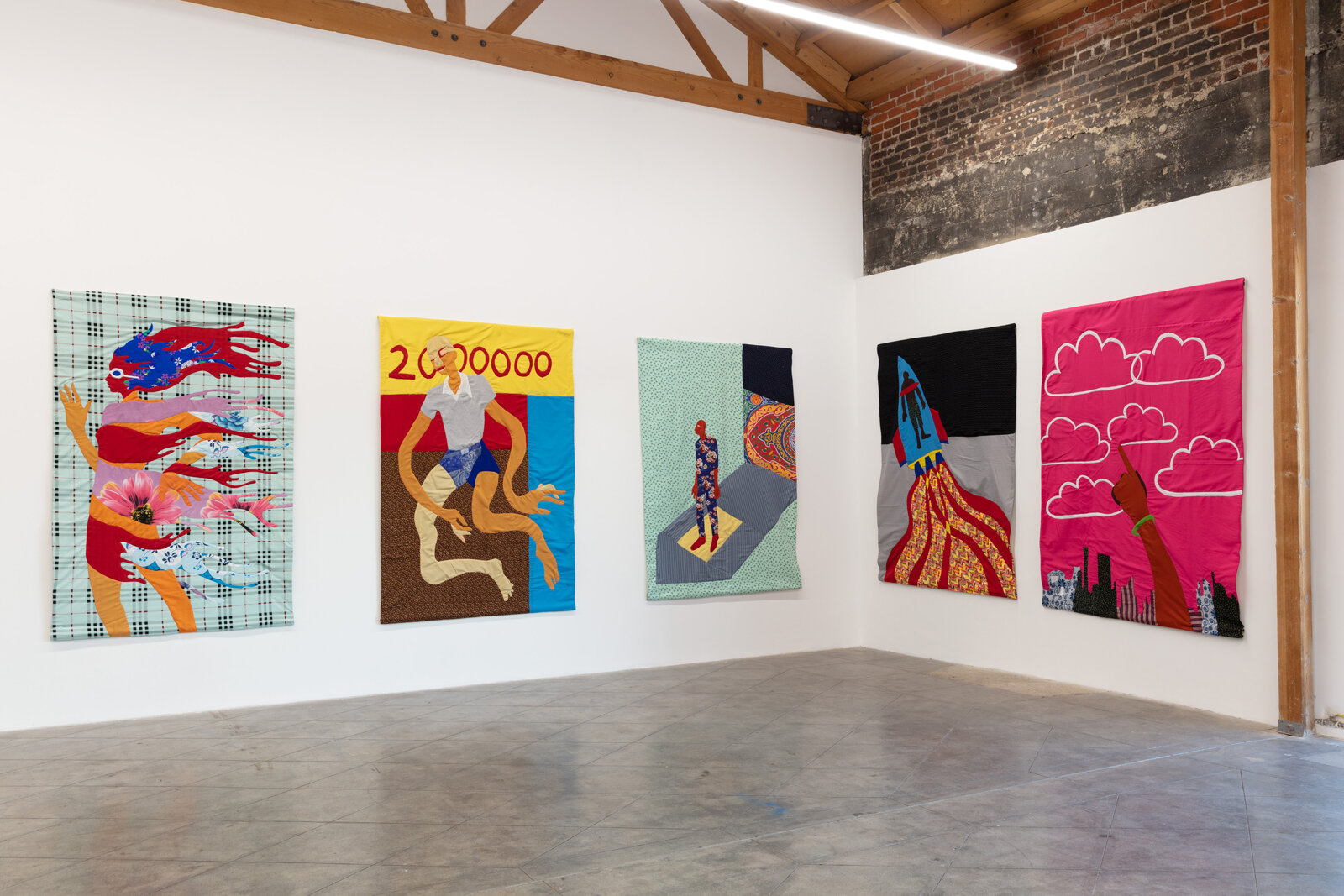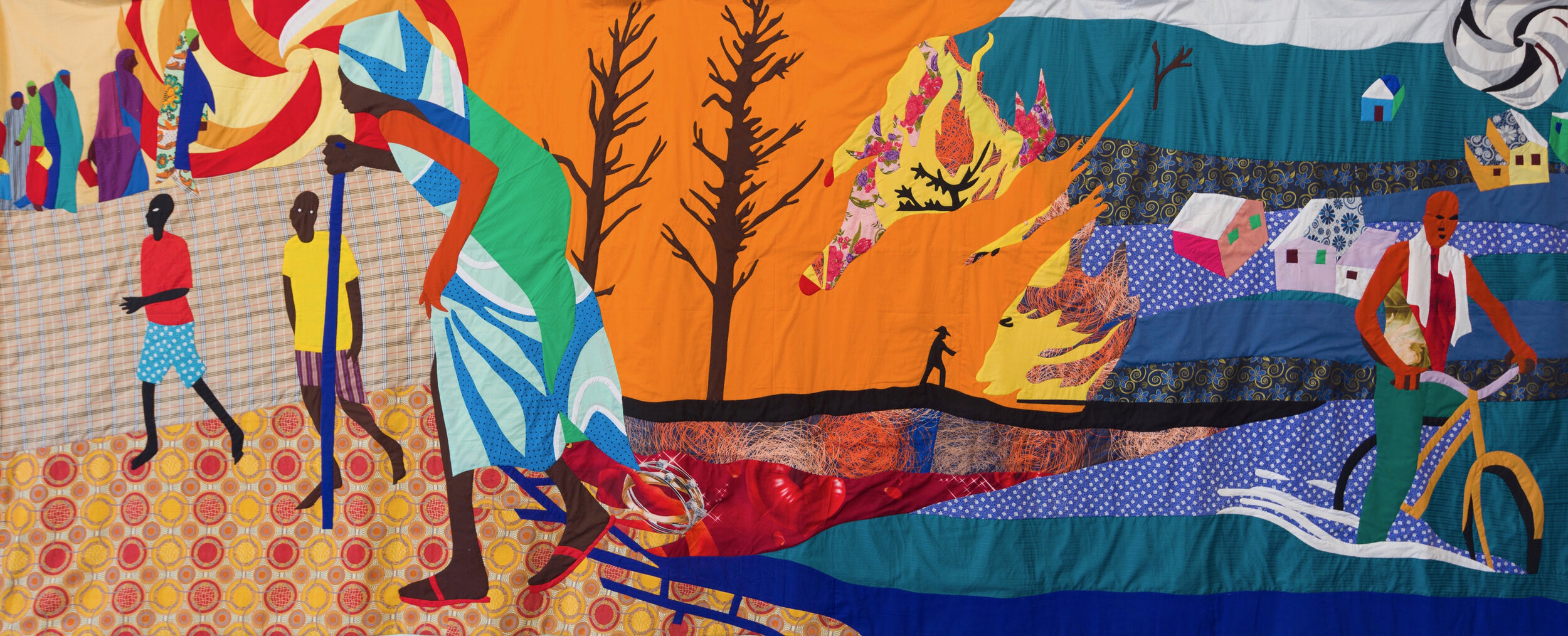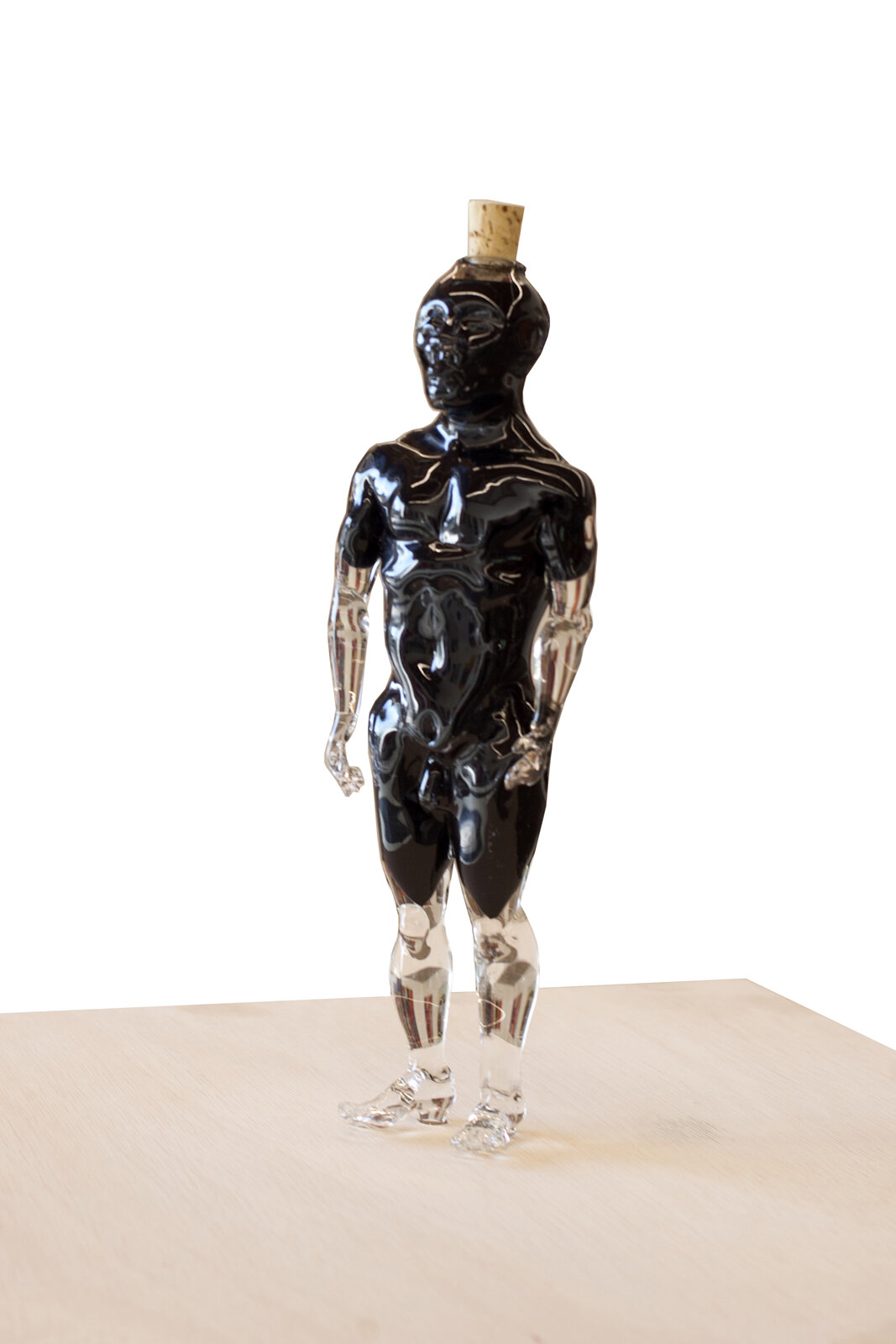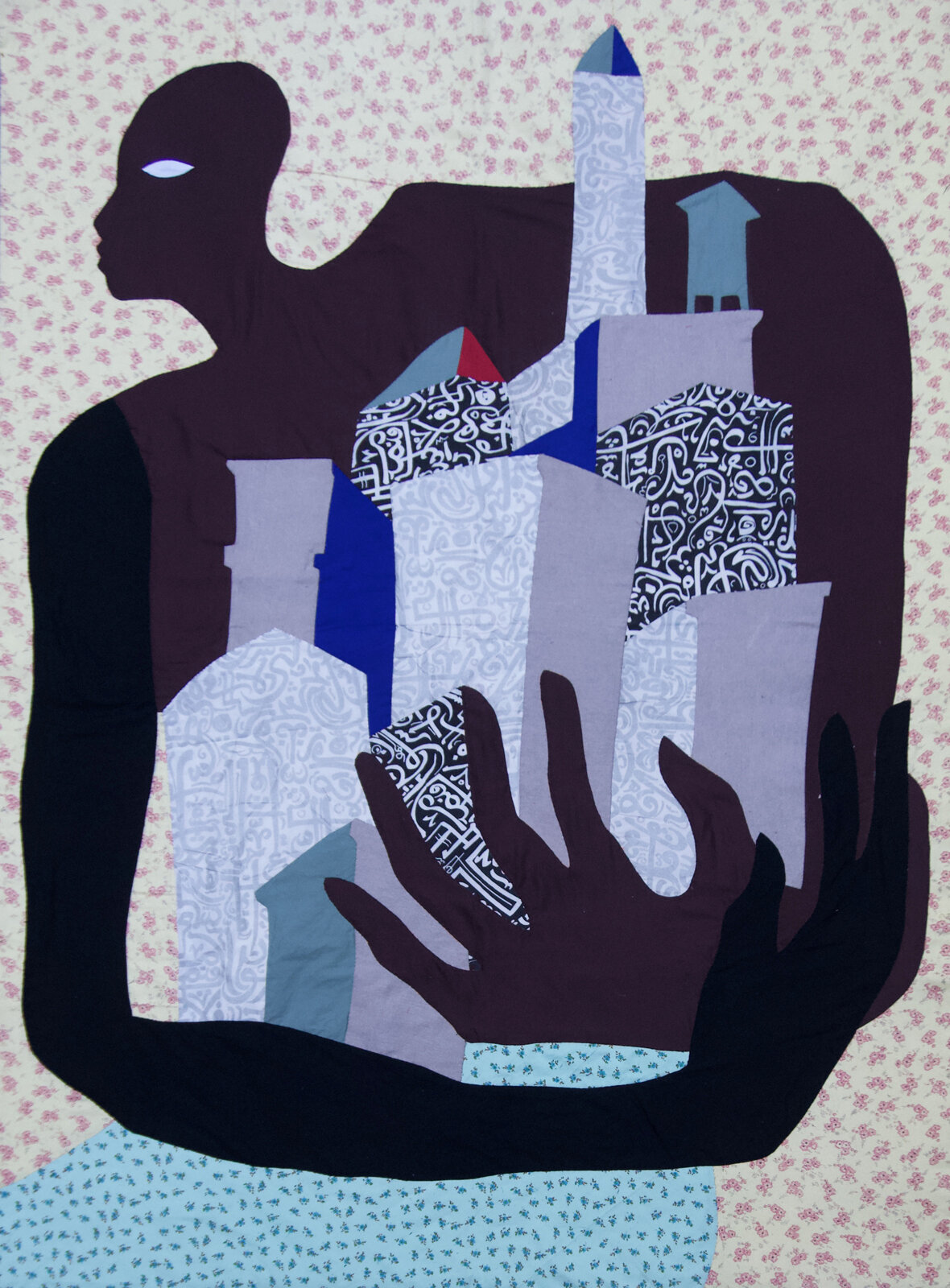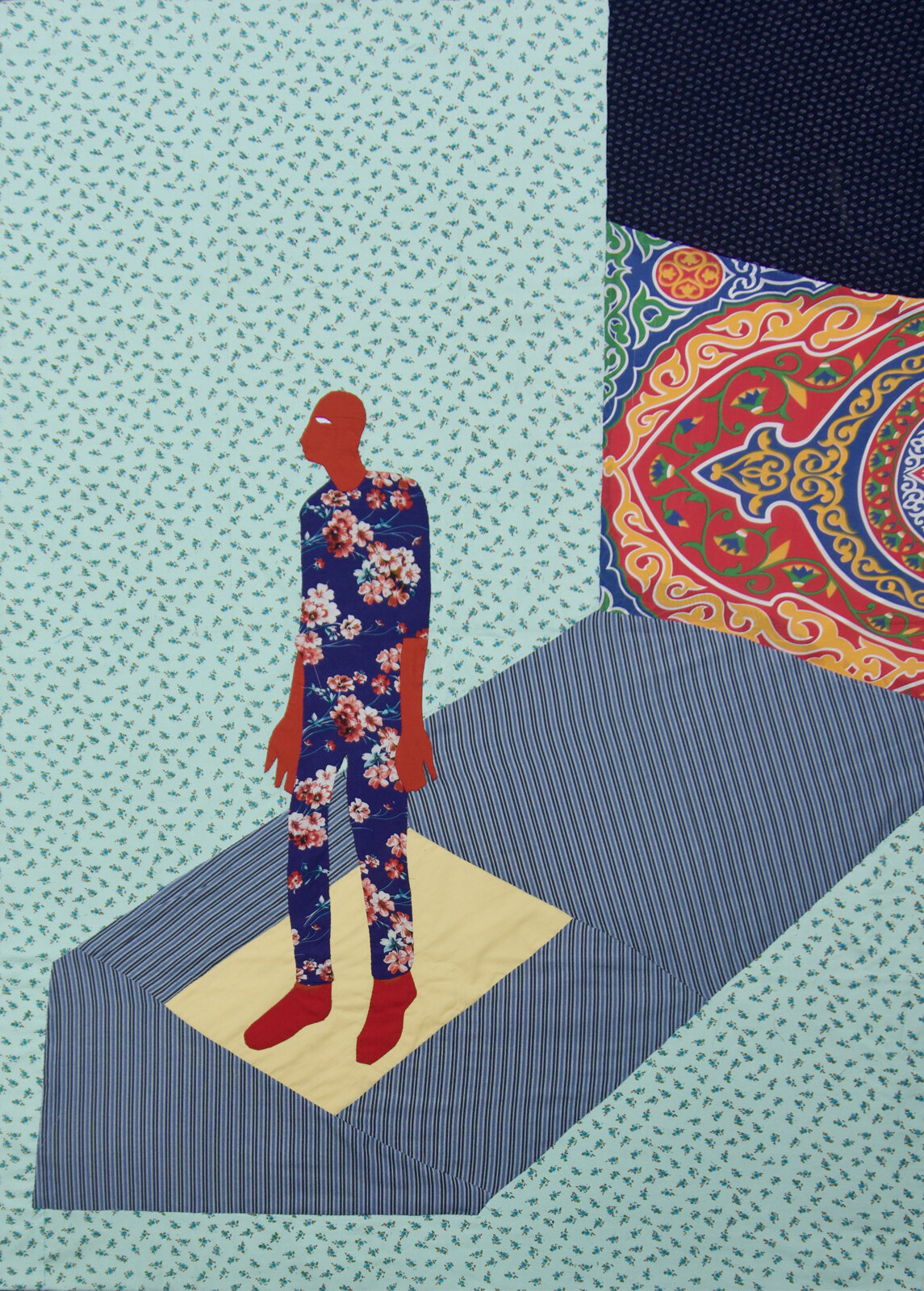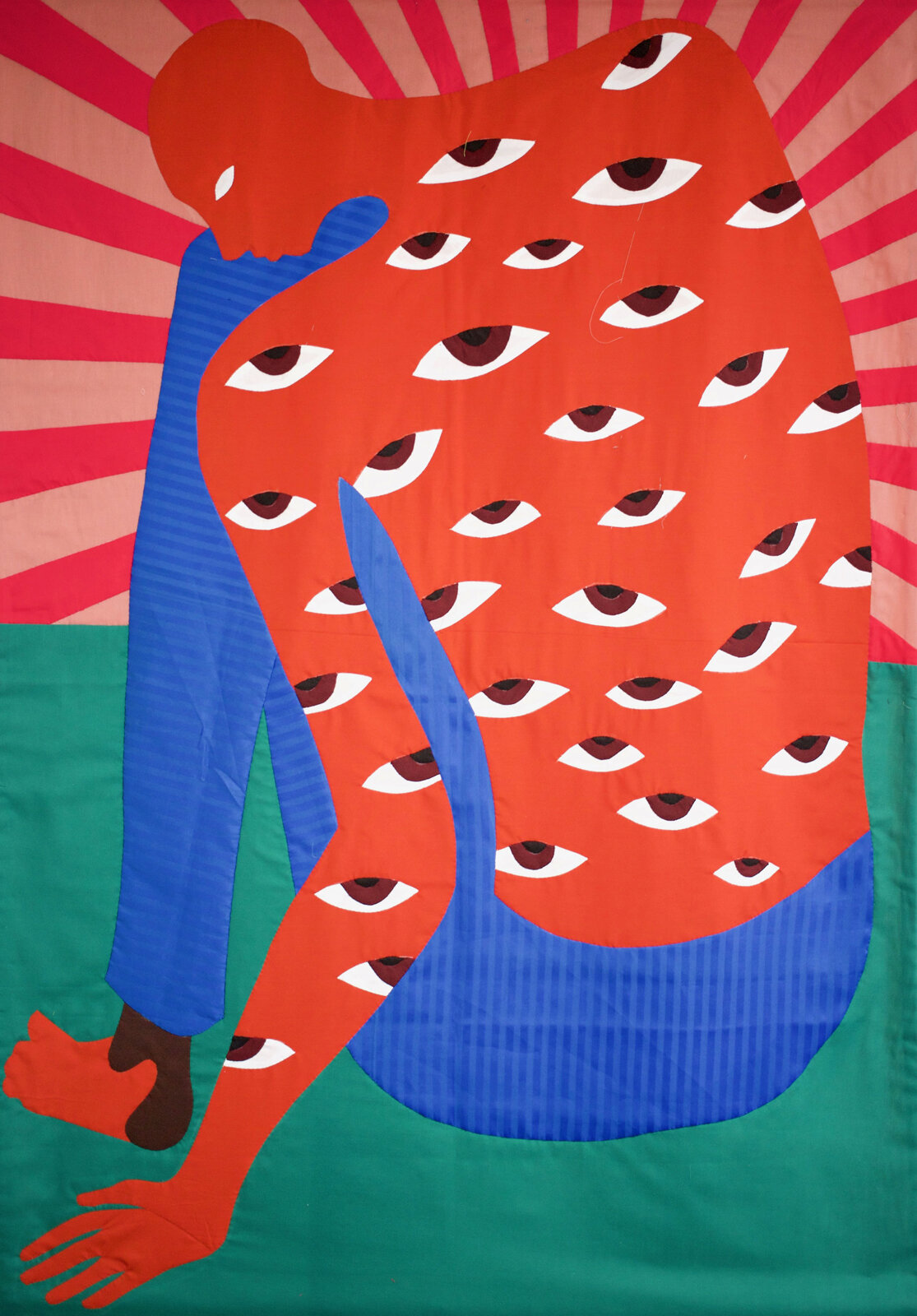interview by Summer Bowie
How does a country like Vietnam, absent of a black community, develop a rich brass band tradition with roots in the American South? How did the British flag inspire a Ghanaian tradition in textiles that is steeped in magical superstition? What do Aimé Césaire, Vaslav Nijinsky, and Emma Goldman all have in common? To find the answers to any of these questions you’d have to ask none other than the multi-disciplinary, head honcho of hybridity, artist Christopher Myers. His practice is as much about connecting the mythologies of ancient Egypt and Greece with those of Judeo-Christian scripture, as it is about connecting the migrations of syncratic practices across the globe and throughout history. His most recent solo exhibition, Drapetomania, at Fort Gansevoort in Los Angeles primarily features hand-sewn flags depicting a wide array of syncratic allegories that in many ways define the globalized, contemporary psyche. These are the mythologies that form the foundation of our collective truth (though we know them to be fiction), and the forgotten legacies that have silently burrowed themselves deep into our cultural fabric. These narratives that inform us and define us find their way to us via oral traditions, dramatic performance, visual art and the printed page, and within all of these disciplines you will find Christopher Myers, obsessively studying the origins of every fiber, the intricacies of every pattern, and the channels of commerce that facilitate it all.
SUMMER BOWIE: Your new show, Drapetomania, at Fort Gansevoort LA features primarily quilted tapestries fabricated in Luxor, Egypt. How did you find these artisans, and why textiles?
CHRISTOPHER MYERS: I was doing research for theater design. I worked with a collaborator, Kaneza Schaal, on a piece about the Egyptian Book of the Dead in 2014. And as part of the research for that book, I went to the Valley of the Kings in Luxor, Egypt. That trip was a gift of a trip. Luxor is a place that has been alive for generations and generations with culture, with religion, with spirituality, with all of the things that we all care about and love. And, while I was there, I ran into these fabric workers who work in the tourist trade. Because, the language that I speak most fluently is the language of speaking to other artists about making things, we quickly got into those conversations: what is the work you’re making, the years of training that go into hands that can sew so deftly, and the ways in which the tourist works aren’t really satisfying to them. So, we started to work together on work that is basic craft, but can speak to not only the traditions that I come from—traditions that are often relegated to poor people, or to women, or to people of color—but also to the other history that I’ve now encountered: from contemporary thinking and performance art, to work in other countries that I think this work is in dialogue with.
I’m thinking especially of Asafo flags, which are a hybrid form in Ghana. The Ghanaian people, when they were colonized by the British, they saw the British parading with their flags and they saw these flags as a kind of magic that was used to exert power over them, and they thought, “we know how to make this magic. We can sew our own.” So, they made flags for parading, for teaching about their own specific identities. And, I love all of that work. Work that takes what the West has given us and then transforms it into art that speaks to the entire world.
BOWIE: In regard to those identities, it seems like you explore a lot of narratives and mythologies that are shared between several different cultures. So, a lot of the stories you are telling with these flags are stories that your fabricators are already familiar with as well. This is such a shared language.
MYERS: Absolutely. If you travel to places in which the pathways of tourism are less trod, you’ll find that the things that overlap in the venn diagrams of our identities end up being these larger myths, these bigger stories about what it means to be human, about ways of talking, about our relationship with the Divine, or our relationship with nature, or our relationship with the mass of humanity, and I think those are the overlaps that I’m particularly interested in. If you grow up like me: Catholic, but super involved in some super syncratic practices, you realize there’s a relationship between a god like Horus in ancient Egypt and the baby Jesus. I’m interested in the syncratic impulse and the mixing of mythologies.
BOWIE: Your sculptures explore the roles that men of African origins have played at various points in history. Can you talk a bit about the generational lineage and its relationship to labor and bondage that you’re referencing in these pieces?
MYERS: One of the things is that there are obviously syncratic impulses that people understand. You see images of God across cultures. But then, there are ways in which our cultural migration, our cultural instinct shows itself. So much of the iron work of the Old South was derivative of the West African iron workers who were forced to migrate here and were enslaved as highly skilled labor in the States. So, the techniques of iron work—the patterning of the wrought iron rails of New Orleans that we associate with upper class housing—are actually patterns that are borrowed from West Africa. I’m interested in those cultural mixings. For example, a collar that is filled with candles; I think a lot about the idea that so many of the people who were actually making shackles during the slavery period in the United States were West African imports. Black people who did the labor of building shackles—we were forced to build shackles for our brothers and sisters. I’m also fascinated by the idea that we did that, but there had to be moments of resistance, even if they were just symbolic. Moments of telling another story, and that is what’s most exciting. Similarly, I’m always interested in the way that no change is ever simple. No bondage is ever without complication.
BOWIE: The rat cage mask—with its reference to vaudevillian sideshows, the bondage of both the human and animal performers involved—it feels like it really calls into question the opportunity for resistance.
MYERS: And what’s interesting to me is that those stories are complicated, always. The 1980s were some of the last vestiges of that kind of performance. There was a guy who had some kind of bone deficiency in which his limbs were severely compromised, and he displayed himself as The Frog Man throughout Texas, and at some point a human rights group got wind of this and sponsored a very strident protest to this practice—without ever having consulted the guy. And the guy said, “If it hadn’t been for my life as a performer, I would still be selling pencils from a moving cart in Texas, but instead I’ve seen the world.” And, I think that we have to look at all of these stories and complicate them. To understand that nobody is that perfect victim that we want them to be.
BOWIE: You started illustrating your father’s children’s books in the ‘90s. Did you initially learn the art of storytelling through him?
MYERS: My first storytelling coach would’ve been my grandfather, who didn’t read a word of English, but was the best storyteller that I’ve ever known. He didn’t read at all, he didn’t read a word of English, he didn’t read anything but he was a great storyteller. That is part of what I mean by coming from a tradition of artists, makers, and creators who may not be recognized by any kind of mainstream world. Of course, my father was a writer. Him being a writer, he was taking some of those things he learned from his father and translating them into a form that could be read, that was legible to others as an art form. But make no mistake, we were all very clear that the chief storyteller in my family was my grandfather, and that we’ve all just been trickling down from his talents.
BOWIE: You pull references from all over the world and across time. Your wide array of disciplines is just as disparate. Is there a common thread at all?
MYERS: I love making things. I have a slight addiction, maybe it’s a problem, I’m sure it would be diagnosable if someone had a word for it. I believe that stories really do change the world. Today, I was in a classroom in Queens, a place called Central Queens Academy Charter School. In that room, 50 or 60 children whose families have come from all over the world, from Tibet, Nepal, Dominican Republic, the Philippines, and China, and every one of them is a hero, they are their own Odysseus. I live in this world in which there are stories around me, there are stories that can change the world, and my job is to find the form, and to usher these stories into the world in a kind of public way. At this moment, I’m preparing for a play that will be produced off Broadway next week that I’ve written about migrations, Cartography. It’s a theater piece for young people thinking about the challenges of migration. The thing that is central is this idea of trying to fight the tide of forgetting that is so often imposed on all of our stories of migration.
BOWIE: In 2016, you presented work alongside Pollock, Warhol and Billie Holiday at Cooper Gallery in a show that explored the intersection between jazz music and visual art. Can you talk about the genesis of that piece?
MYERS: I think that one of the things that is interesting about being African American is the idea that we are some of the original hybridized people. We are some of the first people in the world to kind of have defined identities on that hyphen between two cultures. And jazz is absolutely the central exemplar of that hybridity of mixing European instruments with tonal patterns and rhythms that are from the continent. That being said, that specific set of pieces is a piece that was born in Vietnam.
So, I was living in Vietnam, and early in the morning you hear jazz music kind of wandering through the streets. Like, yo man, where’s this jazz music coming up to my apartment from the street? I ran outside and what I found was a brass band tradition that intersected with other brass band traditions like New Orleans jazz, but it’s used for funerals. So, in the morning you see all these funeral marches and jazz bands, and there were moments of recognition because the form is so indebted to African Americans. So, I began to make a series of uniforms and instruments for this funeral march that would go from Saigon to New Orleans. What was shown at the Cooper Gallery was a piece of that series of instruments that I built with instrument makers that were from Vietnam. It was subsequently made into a film via my friends who were called The Propeller Group, a Vietnamese-American art collective. We were very excited to take this work that is centered on levels and levels of hybridity and cultural movement, and to literalize some of that hybridity, to make almost mythical beings of the instruments, chimera and hydra of trumpets, French horns, and cymbals. That was the center of that piece. And, for real, I think that when you look at so much of the work that we love, it comes from cultural collision.
BOWIE: How exactly did jazz make its way to Vietnam if there’s not a black community existing there?
MYERS: Right, that would be an obvious question for me. What I found was that it comes from the French. James Reese Europe was an African-American bandleader for the military during World War I. He brought jazz to Europe, he brought it specifically to France, so the French took up this brass band tradition in their colonization of Vietnam, who then picked up this tradition that’s been handed down, and handed down, and handed down. What was fascinating was asking the musicians in Vietnam, “Where did you get this tradition from?” And they said, “We don’t know!” This is what I’m talking about in terms of the currency of forgetting, the tide of forgetting, and I’m hoping in some small way can help to stem that tide.
BOWIE: How did your appreciation for Vaslav Nijinsky come about?
MYERS: I’m interested in histories of colonialism. So, Nijinsky as a young Polish talent was taken up into the Russian system and his kind of cultural mix, having been colonized. There’s this thing called drain theory that happens as a result of colonial powers. They take the great talents from the people they are colonizing, and those people become these hybrid figures, people like Nijinsky or Aimé Césaire, or Senghor. So many great poets and intellectual figures are hybrid figures that have been educated in the West, but have come back home and tried to find ways to resurrect their own traditions. Nijinsky is so different, especially because at some point he kind of succumbs to the mental stress and was diagnosed with schizophrenia when he was thirty, and never danced again after having revolutionized the world of dance. But, when you read his journal—he kept a meticulous journal—for six weeks just as he was turning the corner of mental health, and when you read that journal you can see how so much of what was affecting him were the cultural pressures of his time; the split and hybridized identity. At one point he writes, “I’m a Negro. I’m a Chinese. I’m a Red Indian. I’m a White.” And he has kind of lost himself, and lost his own sense of his identity. Not only the colonial experience he’s undergoing, but also the ways in which he is replicating the colonial gaze as a dancer. He also dances as other ethnicities. He dances as a Thai, or as an Indian, and that kind of hybridity, and revealing in his journals was and continues to be very inspiring to me.
BOWIE: Do you think the art world would dance more [socially] if they worked more with dancers?
MYERS: Well, the first thing I would like to say is I very much appreciate your recognition that the art world is abysmal when it comes to dance. So, I think that firstly, the art world has some of the worst parties because of this dance aversion. And I also feel like the art world needs to start to back up their imagination of themselves as being global by getting out of their houses, and I mean that both metaphorically and literally. More and more they’re realizing you see the same people in seven cities. I’m not particularly interested in that party. I wish that more of them would come to some of the events that I continually gather. I’m interested in experiencing things and places that could touch you and change the way you see the world. Hopefully, that’s what the work is doing too.
Drapetomania is on view through February 8 at Fort Gansevoort Los Angeles, 4859 Fountain Avenue. Follow Christopher Myers on Instagram @kalyban

